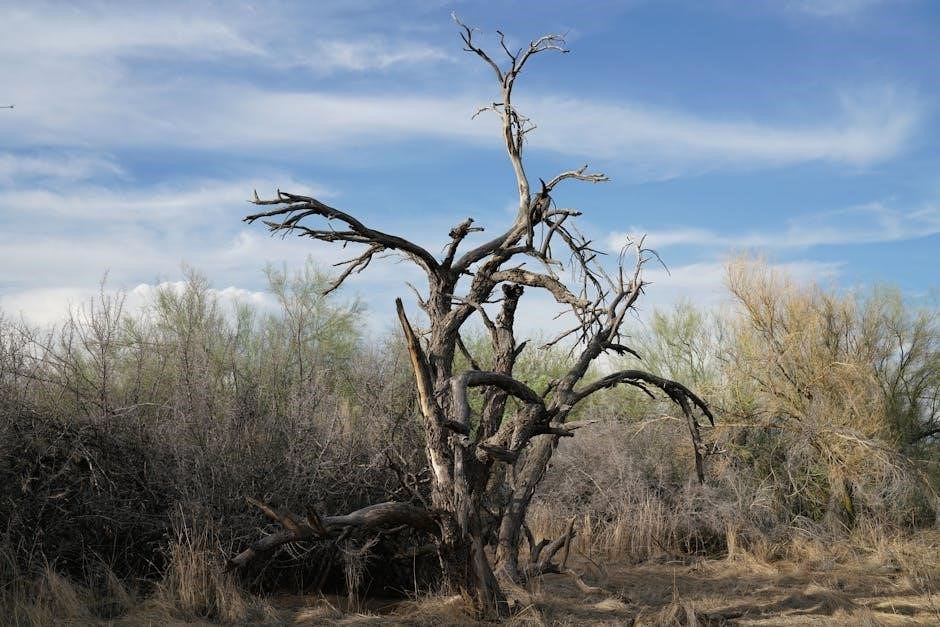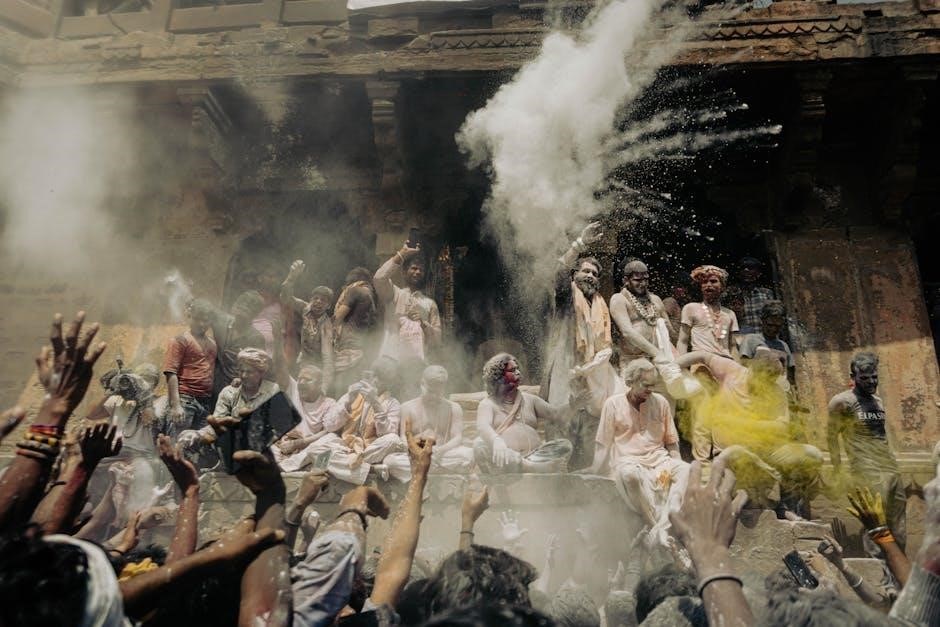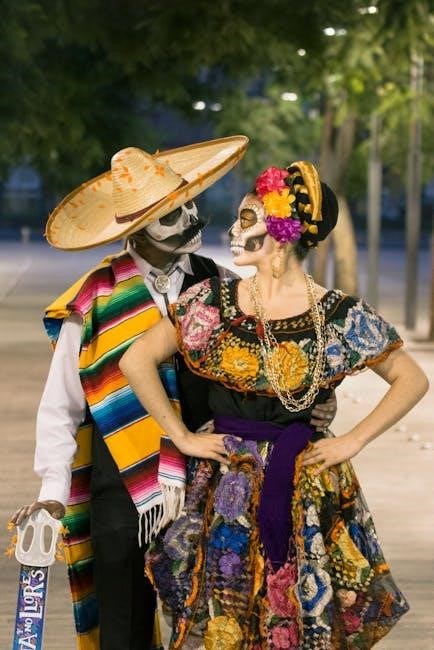Day of the Dead worksheets are engaging resources designed to teach students about Mexico’s vibrant celebration‚ blending cultural insights with educational activities for a comprehensive learning experience.
1.1 Overview of Day of the Dead Worksheets
Day of the Dead worksheets are educational resources that provide interactive and engaging activities for students to learn about Mexico’s vibrant celebration. These worksheets often include reading comprehension exercises‚ vocabulary matching games‚ and creative writing prompts. Designed for various grade levels‚ they cover topics such as the history of the holiday‚ cultural traditions‚ and symbolic elements like altars and marigolds. Many worksheets are available as free PDF downloads‚ making them accessible for teachers and homeschoolers. They are ideal for language arts‚ social studies‚ and cultural enrichment‚ offering a hands-on approach to understanding this meaningful tradition.
1.2 Importance of Using Worksheets for Learning
Worksheets are a valuable tool for structured learning‚ offering a focused approach to understanding complex topics like the Day of the Dead. They provide a clear framework‚ making it easier for students to grasp key concepts. Interactive activities such as crossword puzzles and vocabulary exercises engage students‚ fostering active participation. Worksheets also allow teachers to assess comprehension and track progress effectively. Their versatility makes them suitable for various educational settings‚ ensuring a comprehensive and engaging learning experience that aligns with curriculum goals and promotes student success.

History and Cultural Significance of Day of the Dead
Originating in Mexico‚ the Day of the Dead honors loved ones who have passed‚ blending indigenous traditions with Catholic influences‚ celebrated on November 1st and 2nd with vibrant decorations and altars.
2;1 Origins of Day of the Dead
The Day of the Dead‚ or Día de los Muertos‚ traces its roots to ancient Mesoamerican cultures‚ particularly the Aztecs and Mayans‚ who honored their deceased with rituals and offerings. Over time‚ the celebration evolved‚ blending indigenous traditions with Catholicism after the Spanish conquest. Originally celebrated in summer‚ it shifted to align with All Saints’ Eve‚ creating a unique fusion of cultural and religious practices. The holiday reflects a deep respect for deceased loved ones‚ emphasizing their enduring presence in the lives of the living through vibrant rituals and symbolic decorations.
2.2 Cultural Traditions and Symbols
Central to the Day of the Dead are vibrant cultural traditions and symbolic elements. Families construct elaborate altars‚ or ofrendas‚ adorned with marigolds‚ photographs‚ and favorite items of the deceased. Skulls‚ often decorated with bright colors and patterns‚ represent life’s duality. Traditional foods like pan de muerto and sugar skulls are prepared‚ while parades and music fill the streets. These symbols and practices honor the departed‚ reflecting a celebration of life and death’s interconnectedness‚ ensuring ancestors’ memories endure through communal rituals and artistic expressions.
Educational Objectives of Day of the Dead Worksheets
These worksheets aim to educate students about the cultural significance and traditions of Day of the Dead while enhancing language skills and fostering cross-cultural understanding through engaging activities.
3;1 Teaching Vocabulary Related to Day of the Dead
Day of the Dead worksheets often focus on building vocabulary related to the celebration‚ such as terms like “ofrenda‚” “calavera‚” and “marigold.” These exercises help students connect words with cultural practices‚ enhancing their understanding of the holiday’s traditions. Activities like word searches‚ crossword puzzles‚ and matching games make learning engaging and interactive. By incorporating images and contexts specific to the celebration‚ worksheets ensure students grasp both the meanings and cultural significance of the vocabulary. This approach fosters language acquisition while introducing students to Mexico’s rich heritage.
3.2 Promoting Cross-Cultural Understanding
Day of the Dead worksheets play a vital role in fostering cross-cultural understanding by introducing students to Mexico’s rich traditions and symbolism. Through fact files‚ photographs‚ and descriptions of customs‚ students gain insight into the cultural significance of the celebration. Activities often encourage students to reflect on how different cultures honor loved ones‚ promoting empathy and global awareness. By exploring the vibrant traditions and stories behind the Day of the Dead‚ worksheets help students appreciate the diversity of cultural practices and their importance in preserving heritage.

Types of Day of the Dead Worksheets
Day of the Dead worksheets include vocabulary exercises‚ reading comprehension‚ crossword puzzles‚ word searches‚ and creative writing or drawing activities‚ catering to diverse learning needs and styles.
4.1 Vocabulary Worksheets
Vocabulary worksheets focus on teaching key terms related to the Day of the Dead‚ such as altar‚ marigold‚ and ofrenda. These exercises help students build foundational language skills by matching words to definitions or images‚ creating flashcards‚ or filling in the blanks in sentences. Interactive activities like crossword puzzles and word searches also make learning engaging and fun. Many worksheets are designed for different proficiency levels‚ ensuring that both beginners and advanced learners can benefit. Additionally‚ some resources include visual aids to enhance understanding and retention of the vocabulary.
4.2 Reading Comprehension Exercises
Reading comprehension exercises in Day of the Dead worksheets help students understand the cultural and historical significance of the celebration. These exercises often include fact files‚ short stories‚ or descriptions of traditions‚ followed by multiple-choice questions or short-answer prompts. Some worksheets incorporate photographs or illustrations to enhance comprehension. Activities may also involve identifying main ideas‚ making inferences‚ or summarizing key points. These exercises are designed to improve reading skills while deepening students’ understanding of the Day of the Dead’s customs and symbolism‚ making learning both educational and engaging.
4.3 Crossword Puzzles and Word Search Activities
Crossword puzzles and word search activities are popular components of Day of the Dead worksheets‚ designed to reinforce vocabulary and cultural concepts. These exercises feature key terms related to the celebration‚ such as “altar‚” “marigold‚” and “skeleton‚” helping students connect words with their meanings. Crosswords often include clues about traditions‚ while word searches hide vocabulary within grids for interactive learning. These activities cater to different learning styles‚ making them engaging and effective tools for retaining information about the Day of the Dead’s unique customs and symbols.
4.4 Creative Writing and Drawing Exercises
Creative writing and drawing exercises in Day of the Dead worksheets encourage students to express their understanding and imagination. Activities include writing short stories about loved ones‚ crafting poems inspired by the celebration‚ or illustrating traditional symbols like sugar skulls and marigolds. These exercises foster creativity while deepening cultural awareness‚ allowing students to personalize their learning experience and connect emotionally with the holiday’s themes of remembrance and joy. Such tasks also provide teachers with insights into students’ comprehension and artistic skills‚ enhancing overall engagement and educational outcomes.

Benefits of Using Day of the Dead Worksheets
Day of the Dead worksheets enhance language skills‚ cultural understanding‚ and critical thinking. They foster creativity and provide engaging‚ interactive learning experiences for students of all ages.
5.1 Enhancing Language Skills
Day of the Dead worksheets effectively enhance language skills through vocabulary exercises‚ sentence completion‚ and reading comprehension. Students learn key terms like “altar” and “marigolds‚” while crossword puzzles and word searches reinforce new words. These activities promote grammar practice and sentence structure‚ helping students build confidence in expressing themselves. Interactive exercises engage learners‚ making language acquisition fun and meaningful. By focusing on specific vocabulary and cultural contexts‚ worksheets provide a structured approach to improving both spoken and written communication skills related to the Day of the Dead celebration.
5.2 Encouraging Cultural Immersion
Day of the Dead worksheets foster cultural immersion by introducing students to traditional symbols and customs. Through activities like matching games and reading exercises‚ learners explore the significance of marigolds‚ altars‚ and sugary skulls. These resources provide insights into Mexico’s heritage‚ helping students appreciate the celebration’s deeper meaning. Interactive exercises encourage students to engage with cultural elements‚ fostering empathy and understanding. By incorporating authentic materials‚ worksheets bridge cultural gaps‚ making the Day of the Dead accessible and meaningful for diverse learners‚ while promoting cross-cultural appreciation and respect.
5.3 Developing Critical Thinking and Creativity
Day of the Dead worksheets encourage critical thinking and creativity through interactive activities. Crossword puzzles and word searches challenge students to problem-solve‚ while creative writing and drawing exercises inspire imaginative expression. These tasks help learners analyze cultural symbols and traditions deeply‚ fostering a deeper understanding of the celebration. By engaging in these activities‚ students develop their ability to think creatively and critically‚ linking cultural knowledge with personal interpretation. This approach nurtures both analytical and artistic skills‚ enriching their educational experience and connection to the Day of the Dead.
How to Create Effective Day of the Dead Worksheets
Design engaging worksheets with clear objectives‚ incorporating multimedia and cultural elements. Align activities with curriculum goals to ensure educational value and student interest in the Day of the Dead.
6.1 Design Tips for Engaging Worksheets
Use vibrant colors and imagery inspired by Day of the Dead traditions‚ such as marigolds and sugar skulls. Incorporate clear instructions and age-appropriate content. Add interactive elements like drag-and-drop features or clickable answers for digital worksheets. Ensure layouts are visually appealing with proper spacing and readable fonts. Include cultural symbols and facts to enhance learning; Balance educational content with fun activities to maintain student interest and engagement throughout the worksheet.
6.2 Incorporating Multimedia Elements
Incorporate multimedia elements like videos‚ images‚ and audio clips to make worksheets more engaging. Add interactive features such as clickable answers or drag-and-drop exercises for digital worksheets. Include links to cultural videos or traditional music to enhance cultural immersion. Use high-quality images of Day of the Dead traditions‚ like altars or parades‚ to visually enrich the content. Audio clips can teach pronunciation of key vocabulary‚ while interactive exercises like crossword puzzles or word searches can make learning fun and dynamic. Ensure these elements are accessible and compatible with various devices‚ including tablets and smartphones‚ for flexible learning.
6.3 Aligning Worksheets with Curriculum Goals
Ensure Day of the Dead worksheets align with curriculum goals by matching activities to educational standards. Focus on language skills‚ cultural awareness‚ and critical thinking. Include exercises that tie into vocabulary building‚ reading comprehension‚ and grammar. Align content with grade-specific objectives‚ integrating subjects like history‚ art‚ and social studies. Use teacher resources and downloadable PDFs to streamline lesson planning. This approach ensures worksheets are both educational and relevant‚ supporting broader learning outcomes while fostering cultural understanding and engagement.
Popular Resources for Day of the Dead Worksheets
Popular resources include free PDF downloads from Teachers Pay Teachers‚ ESL worksheets‚ and interactive platforms like LiveWorksheets‚ offering a variety of educational activities for diverse learning needs.
7.1 Free PDF Downloads for Teachers
Free PDF downloads for Day of the Dead worksheets are widely available online‚ offering teachers versatile tools to educate students about this vibrant Mexican celebration. Websites like Teachers Pay Teachers and ESL worksheet repositories provide an array of printable resources‚ including reading comprehension exercises‚ vocabulary lists‚ crossword puzzles‚ and cultural fact sheets. These worksheets are designed for various grade levels‚ ensuring accessibility for both younger and older students. They often feature colorful illustrations and engaging activities‚ making learning about Day of the Dead both educational and enjoyable. Teachers can easily download and print these resources‚ incorporating them into lesson plans seamlessly.
7.2 Online Platforms for Interactive Worksheets
Online platforms offer interactive Day of the Dead worksheets‚ enhancing engagement for students. Websites like LiveWorksheets transform traditional PDFs into self-correcting digital exercises‚ allowing students to complete activities online and submit them to teachers. Platforms such as ESL worksheet repositories and educational marketplaces provide interactive resources‚ including crossword puzzles‚ word searches‚ and vocabulary games. These tools often feature multimedia elements like videos and audio clips‚ making learning immersive and fun. They also enable teachers to track student progress and provide immediate feedback‚ fostering a dynamic and effective learning environment.
7.3 Recommended Websites for Day of the Dead Resources
Several websites offer high-quality Day of the Dead worksheets and resources. Teachers Pay Teachers provides a wide range of downloadable PDFs‚ including lesson plans and interactive activities. ESL worksheet repositories feature customizable templates for vocabulary‚ reading‚ and writing exercises. LiveWorksheets offers tools to convert traditional PDFs into self-correcting digital exercises. These platforms cater to diverse educational needs‚ ensuring teachers can find resources that align with their curriculum goals. They also offer multimedia elements‚ making learning engaging and culturally enriching for students of all levels.
Activities and Exercises for Day of the Dead Worksheets
Engaging activities include vocabulary matching‚ sentence completion‚ crossword puzzles‚ and word searches‚ fostering language skills and cultural understanding through interactive and traditional exercises.
8.1 Vocabulary Matching Games
Vocabulary matching games are a popular feature in Day of the Dead worksheets‚ helping students connect Spanish or English terms with their meanings or images. These exercises often include words like altar‚ marigold‚ or skeleton‚ reinforcing language skills. Interactive PDFs allow students to drag and drop words‚ enhancing engagement. Such activities not only improve vocabulary retention but also introduce cultural elements‚ making learning both fun and meaningful. They are particularly effective for younger learners‚ fostering a connection between language and tradition in a visually appealing way.
8.2 Sentence Completion Exercises
Sentence completion exercises in Day of the Dead worksheets help students practice vocabulary and grammar by filling in the blanks with appropriate words. These exercises often focus on key terms related to the celebration‚ such as altar‚ marigold‚ or ancestors. By completing sentences‚ learners improve their understanding of context and sentence structure. Many worksheets include visual aids or historical facts to enhance engagement. These activities cater to different proficiency levels‚ making them suitable for both beginner and intermediate students. They also promote cultural awareness by linking language to traditions‚ fostering a deeper appreciation for the holiday’s significance.
8.3 Group Activities and Pair Work
Group activities and pair work in Day of the Dead worksheets foster collaboration and cultural understanding. Students engage in interactive tasks‚ such as creating traditional altars or discussing symbolic elements like marigolds and skulls. These exercises encourage communication and teamwork while deepening knowledge of the celebration. Pair work often involves role-playing conversations about Day of the Dead traditions‚ helping students practice language skills in a meaningful context. Group discussions also allow learners to share insights and reflections‚ promoting cross-cultural empathy and appreciation for Mexico’s rich heritage. Such activities make learning dynamic and inclusive‚ enhancing overall engagement.
Challenges in Developing Day of the Dead Worksheets
Developing Day of the Dead worksheets presents challenges‚ including ensuring cultural accuracy‚ balancing educational value with fun‚ and creating engaging designs that resonate with diverse learners.
9.1 Ensuring Cultural Accuracy
Ensuring cultural accuracy in Day of the Dead worksheets is crucial to avoid misrepresentation of this meaningful celebration. Developers must research and verify facts about traditions‚ symbols‚ and practices to maintain authenticity. Consulting Mexican cultural experts or educators ensures the content respects the heritage and avoids stereotypes. Using authentic imagery‚ such as traditional altars and marigold flowers‚ helps convey the spirit of the holiday. Additionally‚ incorporating accurate Spanish vocabulary and translations is essential to preserve the cultural integrity of the worksheets‚ making them both educational and respectful for students learning about this vibrant tradition.
9.2 Balancing Fun and Educational Value
Balancing fun and educational value in Day of the Dead worksheets ensures engaging and effective learning. Activities like crossword puzzles and word searches can make learning enjoyable while teaching vocabulary and cultural facts. Incorporating creative exercises‚ such as drawing traditional altars or writing short stories‚ fosters creativity and deeper understanding. The key is to design tasks that captivate students’ interest without compromising the educational content‚ making the worksheets both entertaining and informative‚ thus enhancing the overall learning experience for students exploring this fascinating holiday.
Feedback and Assessment of Worksheets
Feedback and assessment of Day of the Dead worksheets involve evaluating student responses and gathering insights to refine learning materials‚ ensuring they meet educational and cultural goals effectively.
10.1 Student Feedback Mechanisms
Student feedback mechanisms for Day of the Dead worksheets involve interactive exercises‚ quizzes‚ and class discussions. These tools allow educators to gauge understanding and engagement. Online platforms like LiveWorksheets enable students to submit responses digitally‚ providing immediate insights. Teachers can also use peer reviews and group activities to encourage collaborative learning. Additionally‚ anonymous feedback forms help students share their thoughts on worksheet effectiveness. This data is crucial for refining materials and ensuring they align with learning objectives‚ fostering a more engaging and culturally immersive educational experience for students of all ages and skill levels.
10.2 Teacher Evaluation Criteria
When evaluating Day of the Dead worksheets‚ teachers assess alignment with curriculum goals‚ content accuracy‚ and engagement level. They check if activities promote language skills and cultural understanding. Worksheets are evaluated for clarity‚ age-appropriateness‚ and diversity of exercises‚ such as vocabulary‚ reading‚ and creative tasks; Teachers also consider how well the materials encourage critical thinking and creativity. Feedback from students and ease of integration into lesson plans are additional criteria. Effective worksheets should balance educational value with fun‚ ensuring a meaningful and immersive learning experience for students.

Future Trends in Day of the Dead Worksheets
Future trends include interactive digital worksheets and personalized learning experiences‚ blending cultural immersion with innovative technology to enhance engagement and deepen understanding of the celebration’s significance.
11.1 Digital and Interactive Worksheets
Digital and interactive worksheets are revolutionizing how students learn about the Day of the Dead. These tools transform traditional printables into self-correcting exercises‚ allowing students to complete activities online and submit them directly to teachers. Platforms like LiveWorksheets enable interactive features such as crossword puzzles‚ vocabulary matching‚ and multimedia integration‚ enhancing engagement and accessibility. Digital worksheets provide immediate feedback‚ fostering independent learning and catering to diverse learning styles. This trend not only modernizes education but also ensures that cultural traditions are shared effectively through technology.
11.2 Personalized Learning Experiences
Personalized learning experiences with Day of the Dead worksheets allow educators to tailor activities to individual student needs. Digital platforms enable teachers to create adaptive exercises‚ ensuring each learner engages with content at their own pace. Interactive features like vocabulary matching and multimedia integration cater to different learning styles‚ fostering deeper understanding. These tools also provide immediate feedback‚ helping students track progress and identify areas for improvement. Personalized worksheets enhance engagement and ensure that cultural and linguistic concepts are accessible to all learners‚ making the learning process more effective and enjoyable.
Real-Life Examples of Successful Worksheets
Real-life examples of successful Day of the Dead worksheets include interactive PDF activities for KS2 classes‚ vocabulary exercises‚ and cross-cultural projects that enhance student engagement and learning outcomes effectively.
12.1 Case Studies from Educators
Educators have shared successful implementations of Day of the Dead worksheets‚ showcasing their effectiveness in classrooms. For instance‚ a KS2 teacher used a PDF fact file to engage students with the festival’s traditions‚ while another incorporated interactive vocabulary exercises to enhance language skills. These case studies highlight how worksheets foster cultural understanding and creativity‚ with students creating ofrenda designs and writing reflective stories. Such examples demonstrate the practical benefits of integrating these resources into diverse educational settings‚ enriching both teaching and learning experiences meaningfully.
12.2 Student Testimonials and Outcomes
Students who engaged with Day of the Dead worksheets shared positive feedback‚ highlighting how activities like vocabulary matching and creative writing deepened their understanding of the celebration. Many found the crosswords and word searches fun and educational‚ while others appreciated the cultural insights gained through reading comprehension exercises. Teachers reported improved language skills and increased cultural awareness among students. One student remarked‚ “These worksheets made me feel connected to the traditions and stories behind the festival.” Such outcomes demonstrate the effectiveness of these resources in fostering engagement and learning.
